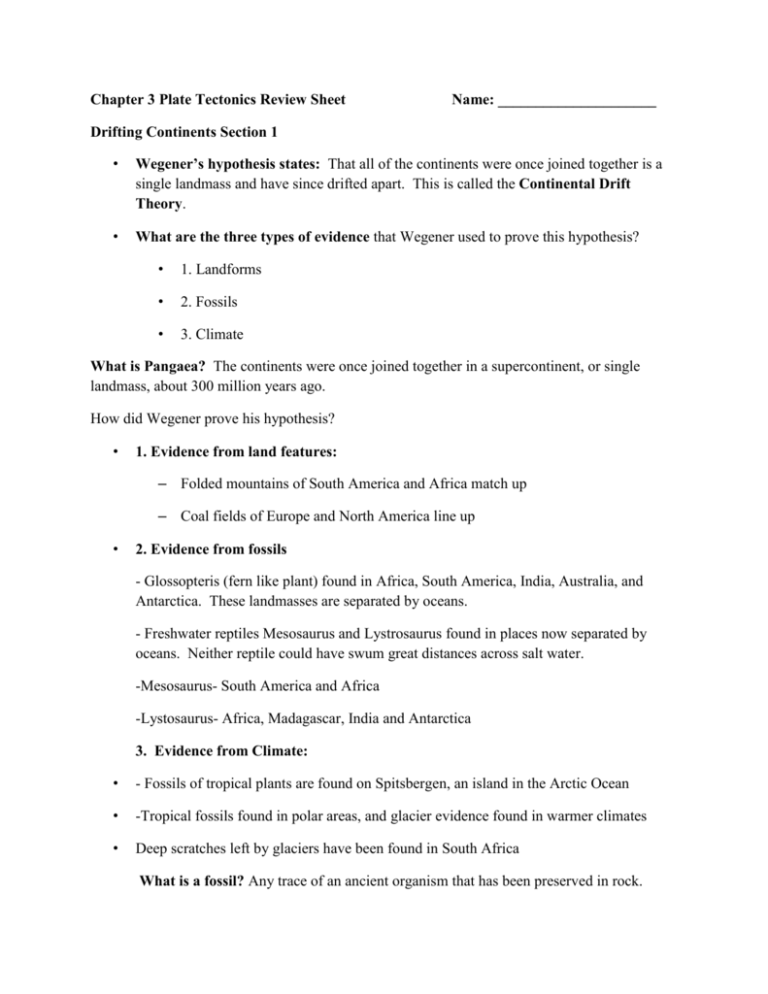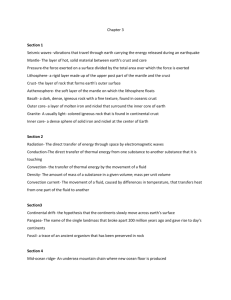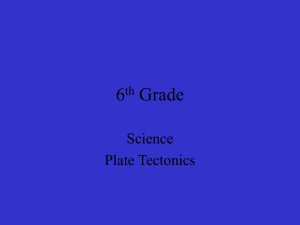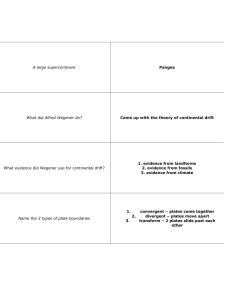Chapter 3 Plate Tectonics Review Sheet Name: Drifting Continents
advertisement

Chapter 3 Plate Tectonics Review Sheet Name: _____________________ Drifting Continents Section 1 • Wegener’s hypothesis states: That all of the continents were once joined together is a single landmass and have since drifted apart. This is called the Continental Drift Theory. • What are the three types of evidence that Wegener used to prove this hypothesis? • 1. Landforms • 2. Fossils • 3. Climate What is Pangaea? The continents were once joined together in a supercontinent, or single landmass, about 300 million years ago. How did Wegener prove his hypothesis? • 1. Evidence from land features: – Folded mountains of South America and Africa match up – Coal fields of Europe and North America line up • 2. Evidence from fossils - Glossopteris (fern like plant) found in Africa, South America, India, Australia, and Antarctica. These landmasses are separated by oceans. - Freshwater reptiles Mesosaurus and Lystrosaurus found in places now separated by oceans. Neither reptile could have swum great distances across salt water. -Mesosaurus- South America and Africa -Lystosaurus- Africa, Madagascar, India and Antarctica 3. Evidence from Climate: • - Fossils of tropical plants are found on Spitsbergen, an island in the Arctic Ocean • -Tropical fossils found in polar areas, and glacier evidence found in warmer climates • Deep scratches left by glaciers have been found in South Africa What is a fossil? Any trace of an ancient organism that has been preserved in rock. Sea-Floor Spreading section 2 A Mid-Ocean Ridge is an undersea mountain chain where new ocean floor is produced and is located at a divergent plate boundary. It is the longest mountain range on Earth. Deep-Ocean Trench is a deep valley along the ocean floor beneath which oceanic crust slowly sinks toward the mantle. As new oceanic crust moves away from the mid-ocean ridge, it cools and becomes more dense. Older oceanic crust is more dense than new oceanic crust because it is cool. Oceanic crust near the mid-ocean ridge is younger than oceanic crust farther away from the ridge. The farther from the mid-ocean ridge a rock sample is taken, the older the rock is. Subduction is the process by which oceanic crust sinks beneath a deep-ocean trench and back into the mantle at a convergent plate boundary. Subduction occurs at the mantle. If subduction occurs faster than oceanic crust can be created, an ocean will shrink. Sea-Floor Spreading is the process by which molten material rises and continually adds new oceanic crust to the ocean floor along both sides of the mid-ocean ridge. What are three types of evidence for Sea-Floor Spreading? Ocean material- pillow lava Magnetic Stripes- ridge Drilling Samples- ocean floor samples Sonar is a device that uses sound waves to measure the distance to an object. Scientists use this type of technology during the mid 1900’s to map the mid-ocean ridge. The Theory of Plate Tectonics Section 3 What are plates? Plates are sections of the lithosphere that slowly move over the asthensophere, carrying pieces of continental and oceanic crust. The theory of plate tectonics states that Earth’s plates are in slow, constant motion, driven by convection currents in the mantle. Most geologists think that the movement of Earth’s plates are caused by convection currents in the mantle. A break in the Earth’s crust along which rocks move is called a fault. The place where two plates meet is called a plate boundary. A place where two plates slip past each other, moving in opposite directions is called a transform boundary. -The San Andreas Fault is an example of a transform boundary. -Earthquakes frequently occur at transform boundaries. -Crust is neither created nor destroyed at transform boundaries. At a convergent boundary, plates come together. -The Himalayas are an example of convergent boundary where two continental plates come together and create this mountain range. At a divergent boundary, plates move apart. -Most divergent boundaries occur along mid-ocean ridges where new crust is added during sea-floor spreading. - Places where pieces of Earth’s crust diverge on land, a deep valley called a rift valley forms.








